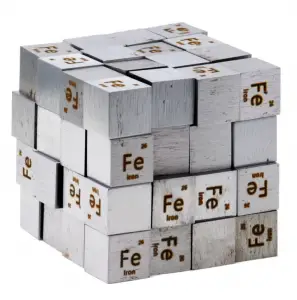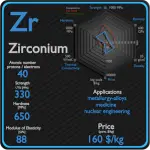This article contains comparison of key thermal and atomic properties of iron and nickel, two comparable chemical elements from the periodic table. It also contains basic descriptions and applications of both elements. Iron vs Nickel.

Iron and Nickel – About Elements


Source: www.luciteria.com
Iron and Nickel – Applications
Iron
Iron is used in numerous sectors such as electronics, manufacturing, automotive, and construction and building. Iron is the most widely used of all the metals, accounting for over 90% of worldwide metal produc0tion. Its low cost and high strength often make it the material of choice material to withstand stress or transmit forces, such as the construction of machinery and machine tools, rails, automobiles, ship hulls, concrete reinforcing bars, and the load-carrying framework of buildings. Since pure iron is quite soft, it is most commonly combined with alloying elements to make steel. Steels are iron–carbon alloys that may contain appreciable concentrations of other alloying elements. Adding a small amount of non-metallic carbon to iron trades its great ductility for the greater strength. Due to its very-high strength, but still substantial toughness, and its ability to be greatly altered by heat treatment, steel is one of the most useful and common ferrous alloy in modern use. There are thousands of alloys that have different compositions and/or heat treatments. The mechanical properties are sensitive to the content of carbon, which is normally less than 1.0 wt%.
Nickel
The global production of nickel is presently used as follows: 68% in stainless steel; 10% in nonferrous alloys; 9% in electroplating; 7% in alloy steel; 3% in foundries; and 4% other uses (including batteries). Nickel is used as a constituent of different types of alloys; for instance, Monel (corrosion resistant material), Nichrome (an alloy used for resistance heating elements), Permalloy (an alloy with high magnetic permeability at low field strength and low hysteresis loss), cupro-nickel, stainless steel, nickel silver, etc. Nickel based alloys (e.g. Fe-Cr-Ni(Mo) alloys) alloys exhibit excellent ductility and toughness, even at high strength levels and these properties are retained up to low temperatures. Nickel and its alloys are highly resistant to corrosion in many environments, especially those that are basic (alkaline). Nickel also reduces thermal expansion for better dimensional stability. Nickel is the base element for superalloys. These metals have excellent resistance to thermal creep deformation and retain their stiffness, strength, toughness and dimensional stability at temperatures much higher than the other aerospace structural materials.
Iron and Nickel – Comparison in Table
| Element | Iron | Nickel |
| Density | 7.874 g/cm3 | 8.908 g/cm3 |
| Ultimate Tensile Strength | 540 MPa | 345 MPa |
| Yield Strength | 50 MPa | 70 MPa |
| Young’s Modulus of Elasticity | 211 GPa | 200 GPa |
| Mohs Scale | 4.5 | 4 |
| Brinell Hardness | 490 MPa | 700 MPa |
| Vickers Hardness | 608 MPa | 640 MPa |
| Melting Point | 1538 °C | 1455 °C |
| Boiling Point | 2861 °C | 2730 °C |
| Thermal Conductivity | 80.2 W/mK | 90.7 W/mK |
| Thermal Expansion Coefficient | 11.8 µm/mK | 13.4 µm/mK |
| Specific Heat | 0.44 J/g K | 0.44 J/g K |
| Heat of Fusion | 13.8 kJ/mol | 17.47 kJ/mol |
| Heat of Vaporization | 349.6 kJ/mol | 370.4 kJ/mol |




















